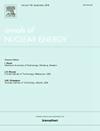Dynamics of wall bubbles in flash evaporation systems: Heterogeneous expansion and microlayer development
IF 1.9
3区 工程技术
Q1 NUCLEAR SCIENCE & TECHNOLOGY
引用次数: 0
Abstract
This study employs the Lattice Boltzmann method to investigate the expansion dynamics of a wall-attached bubble in a flashing chamber. The computational framework is validated against thermodynamic consistency and the Young-Laplace law. Results reveal that bubble expansion follows the Rayleigh-Plesset equation. On hydrophilic surfaces, the contact line movement rate is positively correlated with the contact angle. In contrast, hydrophobic surfaces exhibit an extremely rapid contact line movement rate near a contact angle of , due to coupled pressure-driven inertial and liquid jet entrance forces. A liquid microlayer forms on hydrophilic surfaces but is absent on hydrophobic ones, with its thickness stabilizing after four expansion cycles, following a power-law relationship with lateral spatial variables and an inverse-power-law relationship with the Reynolds number. The contact angle significantly impacts the power-law index. These findings elucidate how inertial, viscous, and capillary forces govern bubble dynamics, providing insights into flash evaporation mechanism in nuclear engineering.
求助全文
约1分钟内获得全文
求助全文
来源期刊

Annals of Nuclear Energy
工程技术-核科学技术
CiteScore
4.30
自引率
21.10%
发文量
632
审稿时长
7.3 months
期刊介绍:
Annals of Nuclear Energy provides an international medium for the communication of original research, ideas and developments in all areas of the field of nuclear energy science and technology. Its scope embraces nuclear fuel reserves, fuel cycles and cost, materials, processing, system and component technology (fission only), design and optimization, direct conversion of nuclear energy sources, environmental control, reactor physics, heat transfer and fluid dynamics, structural analysis, fuel management, future developments, nuclear fuel and safety, nuclear aerosol, neutron physics, computer technology (both software and hardware), risk assessment, radioactive waste disposal and reactor thermal hydraulics. Papers submitted to Annals need to demonstrate a clear link to nuclear power generation/nuclear engineering. Papers which deal with pure nuclear physics, pure health physics, imaging, or attenuation and shielding properties of concretes and various geological materials are not within the scope of the journal. Also, papers that deal with policy or economics are not within the scope of the journal.
 求助内容:
求助内容: 应助结果提醒方式:
应助结果提醒方式:


